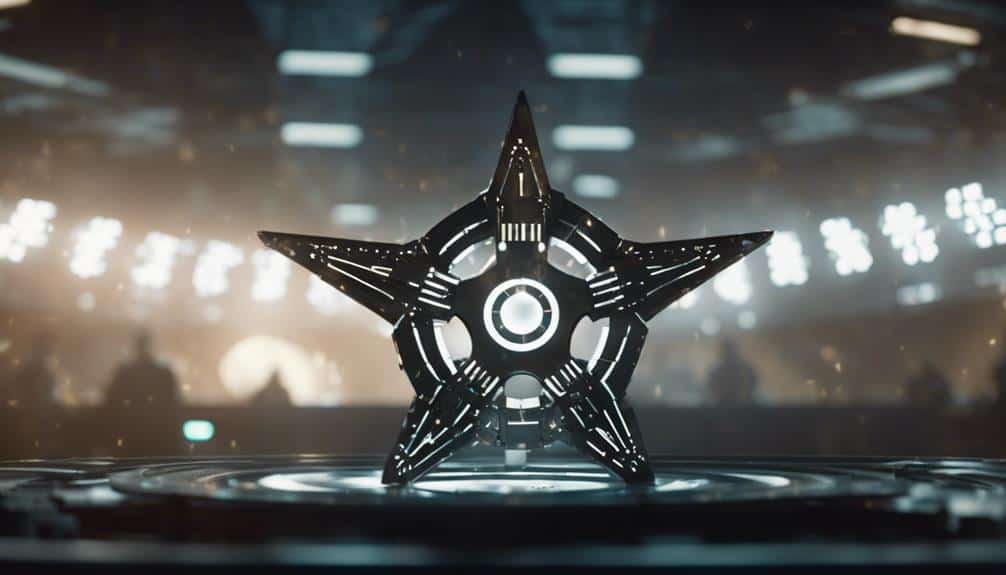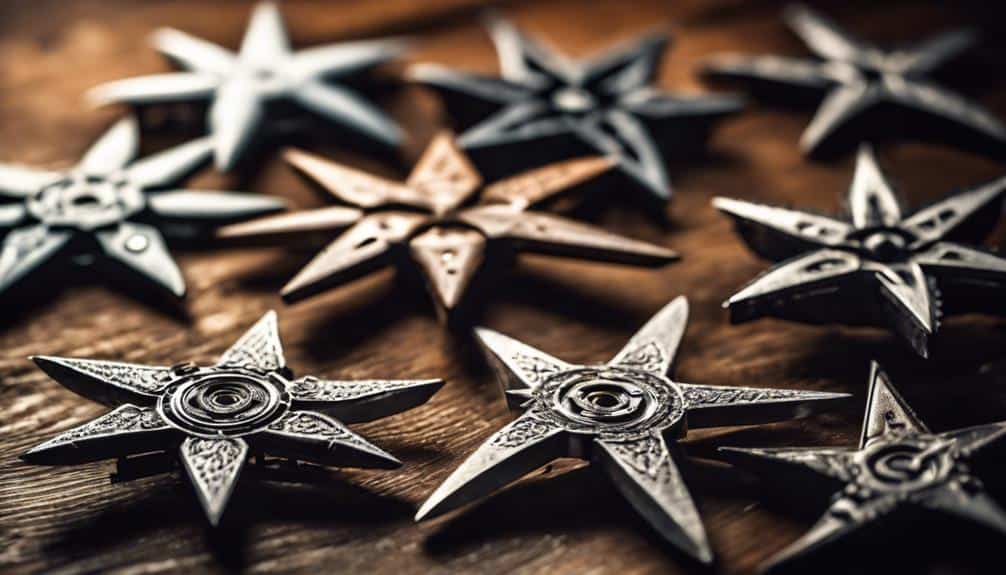Throwing stars, or
shuriken, can do more than just look cool; they can cause everything from annoying paper cuts to potentially
serious injuries. These sharp-edged weapons, hitting unprotected areas like hands or feet, might pierce between 0.9 to 2.3 cm deep. Skilled ninjas, historically, even used them to target arteries or organs, worsening wounds considerably. Sometimes coated with toxins, these stars could turn a small scratch into a critical health hazard. Besides real-world use, their depiction in games like Fortnite shows their
tactical prowess, dealing 35 points of damage per hit. There’s much more to these fascinating projectiles than meets the eye.
Damage Potential
When evaluating the
damage potential of
throwing stars, it’s crucial to reflect on both the immediate physical impact and any additional effects like poisoning.
Shuriken, as a throwing weapon, are designed to inflict damage swiftly and often unexpectedly. In Fortnite, each
shuriken deals 35
edged weapon damage per projectile, resulting in a total damage potential of 105 if all three hit their mark. This illustrates their effectiveness in a controlled virtual environment, but what about in real life?
Traditionally, shuriken can penetrate between 0.9 to 2.3 cm, depending on the skill of the thrower and the target area. This mightn’t sound like much, but hitting a
major artery or essential organ can turn a minor wound into a
serious injury.
Plus, there’s the added layer of
potential poisoning. Historically, some shuriken were coated with toxins to enhance their lethality, meaning even a superficial cut could be deadly. Imagine getting nicked by one and realizing it’s not just a scratch—it’s a ticking time bomb of poison!
Historical Usage
When you think about
shuriken, you might imagine ninjas taking down enemies with deadly precision, but historically, these throwing stars were more about clever tactics and
psychological warfare.
Used primarily to
distract and confuse, shuriken would target exposed body parts, creating fleeting opportunities for warriors to escape or reposition.
The real kicker was their ability to
instill fear and chaos, making opponents second-guess their every move, much like how a surprise pop quiz can throw off your entire day at school.
Tactical Applications in Warfare
Shuriken played a critical role in feudal Japan, serving as distraction tools that allowed ninjas to escape or reposition during combat. These small, versatile throwing weapons weren’t primarily designed for lethality but to create openings and confusion. Imagine you’re a ninja, and you need to slip away unnoticed; a well-aimed shuriken can cause your enemy to flinch, buying you precious seconds.
The wounding capacity of a shuriken was strategically targeted at exposed body parts like the face, hands, and feet. This wasn’t about taking lives but incapacitating foes just enough to gain the upper hand. It’s like turning your opponent into a pin cushion, but with a lot more finesse.
| Weapon |
Primary Use |
Target Areas |
| Shuriken |
Distraction |
Face, Hands, Feet |
| Kunai |
Stabbing/Throwing |
Torso, Limbs |
| Blowgun |
Silent Attacks |
Neck, Chest |
Shuriken could be thrown from the shadows or a concealed position, creating the illusion of an invisible attacker. This made them perfect for ambushes, where surprising your enemy was key. It’s like being a ghost with a lethal touch, making every throw count without exposing yourself to danger.
Psychological Impact on Enemies
Imagine you’re in the middle of a
battlefield and suddenly, out of the shadows, small stars fly through the air, creating panic and confusion among your ranks. These are
shuriken, the iconic throwing stars used by ninjas, and their
psychological impact on enemies can’t be overstated.
Historically, ninjas wielded shuriken to instill
fear rather than to inflict lethal damage. The mere sight of these stars, especially when thrown in darkness, contributed to the
illusion of an invisible attacker, adding a terrifying
element of surprise in ambushes.
Picture it: you’re already on edge from the chaos of battle, and then these stars start appearing from nowhere. This heightened sense of danger could lead you to overestimate the ninja’s capabilities, potentially causing you to retreat or make hasty decisions.
Ninjas cleverly exploited societal fears and folklore, amplifying the psychological impact of shuriken. Think of it like a horror movie—sometimes, the anticipation is scarier than the monster itself.
This psychological tool allowed ninjas to gain
tactical advantages without direct confrontation, making shuriken an essential component of their
strategy.
Modern Applications
In modern martial arts, enthusiasts use
throwing stars to showcase their
accuracy and technique in various demonstrations and competitions. These modern applications highlight the precision and skill required to effectively use shuriken, even though their wounding capacity of recently has been more symbolic than practical.
Many martial arts schools include
shuriken training in their curriculum. Here, you’ll learn safety, proper handling, and effective throwing methods. This training isn’t about becoming a ninja warrior but about appreciating the art form and its
historical significance. Plus, aiming for a
bullseye can be incredibly satisfying!
Shuriken competitions are another exciting modern application. Participants aim to hit specific targets at varying distances, testing their
precision and control. These events emphasize technique and accuracy, making them thrilling to watch and participate in.
There’s a resurgence of interest in traditional shuriken techniques, emphasizing their
cultural significance. Additionally, modern adaptations of shuriken appear in films and video games, often exaggerating their lethality.
Ultimately, the modern applications of throwing stars celebrate their rich history and the skill required to master them.
Legal Considerations
When it comes to owning
throwing stars, you’ll find a wildly varied
legal landscape depending on where you live, and traversing it can be trickier than mastering a ninja flip!
In countries like Canada and the UK, possessing shuriken can land you in hot water without
proper authorization, while in the U.S., states like California and New York have their own sets of rules you’ll need to follow.
Some places might let you own these sharp beauties, but don’t be surprised if you need a
special permit or have to jump through a few hoops to stay on the right side of the law.
Regional Regulations Overview
The legality of shuriken, or throwing stars, varies widely, with some regions outright banning their possession while others enforce strict regulations and require permits.
For instance, Belgium and the Netherlands have no tolerance for these ninja weapons, categorically prohibiting their ownership.
In Canada, shuriken fall under SOR/98-462, a regulation that places them alongside other prohibited or restricted items, clearly defining their legal categorization.
In the UK, under the Criminal Justice Act 1988, shuriken are considered offensive weapons, meaning if you’re caught with one, you could face some serious legal repercussions.
Even within the U.S., the rules are all over the place. States like California and New York impose strict limits, demanding permits or certificates just to legally own these stars. It’s almost like you need a secret ninja license!
- Belgium and the Netherlands: Total prohibition, no ninja antics allowed.
- Canada: Listed under SOR/98-462, restricted with serious regulations.
The capacity of recently developed legal frameworks highlights a complex landscape where owning a throwing star can range from a complete no-go to a regulated privilege.
Always check your local laws before channeling your inner ninja!
Permits and Restrictions
Often, you’ll find that owning a
throwing star isn’t straightforward and requires maneuvering through a maze of
permits and restrictions. Legal categorization varies greatly by country and even within regions.
For example, in Belgium and Canada, possession of shuriken is
outright prohibited. The UK considers them
offensive weapons under the Criminal Justice Act 1988, meaning you can’t carry them without lawful authority.
In the United States, the situation is equally complex. States like California and New York impose
specific restrictions. California Penal Code Section 22410, for instance, lays out clear guidelines on throwing stars, making it vital to know your
local laws. Some jurisdictions might allow ownership but require specific permits, reflecting concerns over safety and misuse.
Obtaining these permits can be a bureaucratic adventure. You might need to demonstrate a
legitimate reason for ownership, like martial arts training, or meet certain certifications.
It’s like trying to
navigate a labyrinth—one wrong turn and you could face hefty fines or even legal trouble. So, always check your local regulations and stay informed. After all, you wouldn’t want your ninja aspirations to land you in hot water!
Shuriken Types
Ever wondered about the different types of shuriken and their unique characteristics? Shuriken, often known as ninja stars, come in various shapes and sizes, each with its own distinct features and uses. Let’s investigate the fascinating world of these traditional Japanese throwing stars and explore their diversity.
There are primarily two main types of shuriken:
bo shuriken and
hira shuriken.
Bo shuriken are straight spikes, typically measuring between 12 to 21 cm in length and weighing between 35 to 150 grams. These sleek, needle-like projectiles are designed for throwing with precision, though they’re more about distraction than causing serious harm.
On the other hand, hira shuriken, often called ninja stars, are flat metal plates with multiple sharp points. These can be made from various materials, including coins and carpentry tools, and may even feature a central hole for easier transport and improved aerodynamics. Their design often reflects the specific schools or regions of the shurikenjutsu tradition.
Here’s a quick breakdown:
- Bo Shuriken: Straight spikes, more about precision and distraction.
- Hira Shuriken: Flat plates, multiple points, better aerodynamics.
Strategic Use
Mastering the
strategic use of
throwing stars can turn the tide of battle, making each throw a
calculated and deadly move. Envision you’re in the heat of
combat, and your enemy is closing in. With a swift flick of your wrist, you release a throwing star, targeting a
weak point. That’s 35 points of edged weapon damage right there, enough to make any foe reconsider their approach.
Strategic use means more than just hurling stars willy-nilly. You’ve got to aim for exposed areas, like joints or unarmored spots, to maximize
damage output. And don’t forget, throwing stars have a 10-second
cooldown. This isn’t just a waiting game; it’s a chance to plan your next move, maybe combining stars with other abilities or weapons for multi-target attacks. Imagine this: you throw a star, then follow up with a quick melee strike—your opponent won’t know what hit them.
Energy management is essential too. Proper allocation means you can keep throwing stars more frequently, maintaining pressure on your enemies. So next time you’re in a skirmish, remember: with strategic use, each throwing star can be a game-changer.
Frequently Asked Questions
A throwing star’s effectiveness depends on your accuracy and skill. Historically, they were distractions, not primary weapons. Modern applications can improve their impact, but they still can’t match firearms or larger melee weapons in lethality.
Is the Throwing Star a One-Hit Kill?
You’re wondering if a throwing star is a one-hit kill. Historically, throwing star lethality depends on martial arts techniques and accuracy. While they can be lethal, they’re not guaranteed to kill instantly, especially against armored targets.
What Is the Effective Range of a Shuriken?
You’ll find the effective range of a shuriken is about 20-30 feet. Using proper throwing techniques, historical usage shows accuracy, while modern applications in games like Fortnite highlight their mid-range capabilities.
Were Shurikens Actually Useful?
You’d find shurikens were quite useful. Their historical significance in martial arts and weapon evolution lies in their versatility for distraction and psychological impact, rather than lethality, enhancing their effectiveness in various combat scenarios.








2 Responses